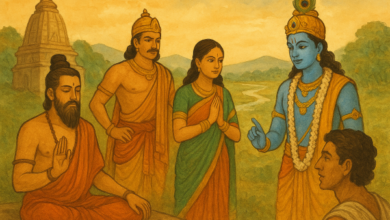Understanding Sankardev’s monotheism in the religious context of the time

 Do not serve/ other Gods and Goddesses / do not eat their offerings / do not look at their idols / do not enter their house / devotion will be adultery.
Do not serve/ other Gods and Goddesses / do not eat their offerings / do not look at their idols / do not enter their house / devotion will be adultery.
This is allegedly one of the most controversial writings of Sankardev from the Bhagavad. What kind of monotheism did Sankardev practise? This is perceived to be a divisive statement. As per the instructions of Sankardev, can we worship the idol of Goddess Durga? Many scholars doubt it to be a later addition. It’s also true that some mythological books are manipulated for vested interests.
Some people of other sects have gone to such an extent that they demand the ban of the holy book in toto where it’s mentioned. Whatever it may be, we cannot clarify now. But we can analyse the authentic necessity of monotheism in the socio-religious background of Assam of that time. Therefore, we have to revisit the history of ancient and medieval Kamrup to understand the context.
Scenario of ancient Kamrup
The Vajrayana sect of Buddhism was prevalent in Kamrup. They practised Tantrism and chanted “Mantras” (Holy sound). This is not the Buddhism of peace and love. Much dissension arose and was divided into many sects. Tantricism was prevalent in the pre-Sankari period.
During the time of departure from India, the sects of Buddhism became barbaric, lascivious and demonic. The Kamakhya temple was their hub of activities. “The meditations of the Vajrayana were often psychopathic… In the sexual rites of tantric Buddhism, all taboos were lifted. Even incest was permitted, for what was sin to the ignorant was virtue to initiate. Drinking of alcohol, meat-eating, killing of animals, and sometimes even of human beings — every imaginable sin — were practised at the tantric covens.” (The Wonder That Was India by AL Basham)
All the perceived immoral physical pleasures are paths of salvation for them. As in the aboriginal savage society, sex is the only attractive impulse for them between men and women. All women-centric ceremonies were at night. Like in the Rasa mandala, all men and women sat in a circular form.
How did tantrik Buddhism appear?
The history of Tantricism of Assam originated in the Kamakhya temple from the seventh century onwards. “… The fusion of Sakta, Tantricism and Buddhist ideas. In the Buddhist Tantric circle Kamrupa or Kamakhya has been recognised as an important holy place (pitha).” (The Comprehensive History of Assam).
On the other hand, it is also called the Vamachari custom of worship.
The culture, history or religion is not static. lt has changed with time and environment. Everything is born out of assimilation and influence. Buddhism originated in India and spread to China, Japan and Sri Lanka. So, these countries have natural closeness with India. Taoism, the traditional religion of China, also got mixed with Shakta of Hinduism. Therefore, Taoism has similarities with Shaktism.
Chinese scholar Huang Xichuan had expressed a significant view in this regard. He was associated with the Institute of South Asian Studies of Beijing University), “…in its last stage Buddhism mixed with Hinduism again; in other words, Vajrayana mixed with Sakta. It is almost difficult to distinguish between Vajra-Yana and Sakta, either in the object of worship, the God-spirits or in the religious rituals.”
OTHER ARTICLES BY THE AUTHOR:
Appearance of Sankardev
Sankardev appeared at this juncture. He tried to simplify the way of worship in religion. To eradicate the corrupt practices of idolatry and evil practices, Sankardev propounded “Hari Naam” (Holy song of God) as a way of salvation. Nothing has to be offered to Deity.
According to Sankardev, “The offerings before the deity are nothing but barbarism and cruelty in the name of religion.”
The preaching policy of Indian Bhakti saints is different from state to state. Sankardev tested the religious policies on Assam’s socio-religious perspective. His strategy was not radicals like Dadu Dayal or Kabir. He emphasised devotion and loyalty. Loyalty is the main weapon to rule a kingdom of religion. Attachment and love beget devotion.
Sankardev had not removed the admiration of Gods and Goddesses other than Lord Krishna from the Srimad Bhagavad. But he warned the common people not to resort to Vamachari custom, fearing people might revive idolatry.
The Devadasi dance was practised in the temples of Hayagriva of Hajo, Kamakhya and other Shiva temples during the Middle Ages. It is also very shocking that “not only in Shiva temple, but also in Buddha and Vishnu temple, this system was prevalent.” (Asomiya Sanskriti)
Sankardev was liberal about women’s rights. But seeing the Vamachari custom, he was initially cautious to grant absolute freedom to women. Many critics wrongly term this act of Sankardev as a narrow outlook.
We can conclude from the above discussion that any worship with floral tributes and “mantras” is not philosophically against the tenet of Sankardev. It may be Durga Puja or any other idol worship. The offerings of living beings should no longer be practised. It’s worth mentioning that Sankardev himself installed a statue of Madana Gopala in Dhuwahat. So, people have to dispel many false conceptions swirling around Sankardev in the name of monotheism.





